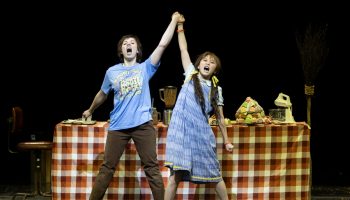On paper, it first seemed a curious pairing: Ástor Piazzolla’s joyous The Four Seasons of Buenos Aires on the first half of the Chautauqua Symphony Orchestra program and, after intermission, Dmitri Shostakovich’s brooding fifth symphony. In reality, this odd couple brought the Russian master’s staggering work into sharper focus by making one question the emotions that music can convey and evoke.
And there was also a Russian connection between the two halves. (Everyone seems to be looking for Russian connections these days.) Piazzolla’s piece was heard not as he wrote it for a small ensemble, but rather in a version for string orchestra crafted by the contemporary Ukrainian composer Leonid Desyatnikov.
Piazzolla originally set out to write neither a four-movement suite nor an orchestral work. The prolific Argentine composer, who revived and elevated the tango to new status, first wrote “Verano Porteño” (Summer in Buenos Aires) in 1964. He scored it for his five-instrument ensemble consisting of violin/viola, piano, electric guitar and double bass, in which he played the bandoneon, sometimes called the “tango accordion.” Over the next few years he wrote three more pieces to depict the other seasons; occasionally he would perform the four together, but more often not.
In the late 1990s, the celebrated violinist Gidon Kremer enlisted Desyatnikov to adapt the music for a small string orchestra. The result is less a conventional arrangement than a co-composition. Desyatnikov decided to weave in quotations from Antonio Vivaldi’s famous quartet of Baroque violin concertos “The Four Seasons,” as well as allusions to other pieces, such as Pachelbel’s “Canon.”
CSO Music Director Rossen Milanov conducted a stylish and committed performance with Bulgarian violinist Bella Hristova as soloist. She deftly dispatched the ingenious instrumental writing that includes evocative extended techniques. Concertmaster Brian Reagin and cellist Jolyon Pegis interjected effective solos, as did other CSO principals throughout the evening.
Desyatnikov’s adaptation imaginatively melds South American and Baroque musical styles. Baroque dance suites employed countless dances from around the world, including as far away as the Mexican zarabanda that became the sarabande. What is often lost in Desyatnikov’s version is the distinctive sound Piazzolla cultivated, particularly as a virtuoso of the bandoneon. At times cleverness replaces intimate atmosphere, nostalgia and swing.
The charm of Piazzolla’s music brought out, even more than usual, the troubled and troubling intensity of Shostakovich’s brilliant Fifth Symphony, terrifically rendered by Milanov and the CSO.
The circumstances of the work’s creation are well-known: Shostakovich was the shining star of the Soviet musical heavens and the beneficiary of international fame when, in 1936, Stalin attended a performance of his second opera, Lady Macbeth of the Mtsensk District, and left before it ended. A few days later a scathing article appeared in Pravda, the official organ of the Communist Party, and Shostakovich was put on notice that he had to mend his ways: “This game may end badly.”
Those terrifying words were life-threatening; this was not just a bad review that could hamper a thriving career. Shostakovich was well aware of the show trials and mounting purges, as friends and colleagues disappeared or were killed. The musical establishment, with a few brave exceptions, lined up in opposition. Shostakovich was working at the time on a massive Fourth Symphony, which he withdrew just before the premiere.
The stakes were therefore enormously high when Symphony No. 5 premiered in Leningrad in late 1937. Although its worth and meaning were fervently debated, the work resonated deeply with audiences. Reliable accounts state that the funereal third movement moved many listeners to tears. Members of the audience, one by one, began to stand during the extravagant finale. The composer Maximilian Steinberg wrote in his diary: “The ovation was stupendous, I don’t remember anything like it in about the last 10 years.”
Thus, from the start performers and audiences alike perceived the power of what became the most often performed and beloved of Shostakovich’s 15 symphonies. Audiences today may not recognize the references to lamenting music of the Russian Orthodox Church or to earlier works by the composer, but can still feel the intense emotions.
A major point of contention, as Milanov observed in an interview with The Chautauquan Daily, is the last movement. Is its seemingly optimistic triumphalism genuine or contrived to please the authorities? We will never know. The composer never said (at least not reliably — there are fraudulently presented memoirs that supposedly give an answer) and it wouldn’t much matter if he had. Interpretations of the piece can accommodate different approaches and listeners can come to different conclusions. Perhaps it is the ambiguity still surrounding the symphony that partly accounts for its continued appeal and prominence.
As Milanov remarked, the coda has been a particular sticking point. Recordings preserve the varied interpretations of Evgeny Mravinsky (who conducted the premiere); Shostakovich’s son Maxim (who conducted here in the early 1980s); the composer’s friend Mstislav Rostropovich; Leonard Bernstein (who brought the New York Philharmonic to the USSR and won the composer’s praise); and others. Milanov took a faster tempo than some, but that does not necessarily mean the effect was affirmative — the word he used was “defiant.” Regardless, this was a well-shaped performance that the orchestra played with both subtlety and verve.
Musicians and audience alike are still testing out the acoustics of the rebuilt Amphitheater and until permanent benches are installed, matters this summer are somewhat provisional. Initial impressions are that wind instruments, the brass in particular, now more easily overwhelm the strings. Milanov is experimenting with seating and for this performance the horns were moved, which seemed an improvement.
Christopher H. Gibbs is James H. Ottaway Jr. Professor of Music at Bard College, co-artistic director of the Bard Music Festival, and executive editor of The Musical Quarterly. Among his books are The Life of Schubert and The Oxford History of Western Music, College Edition, co-authored with Richard Taruskin. Since 2000 he has written the program notes for the Philadelphia Orchestra.





